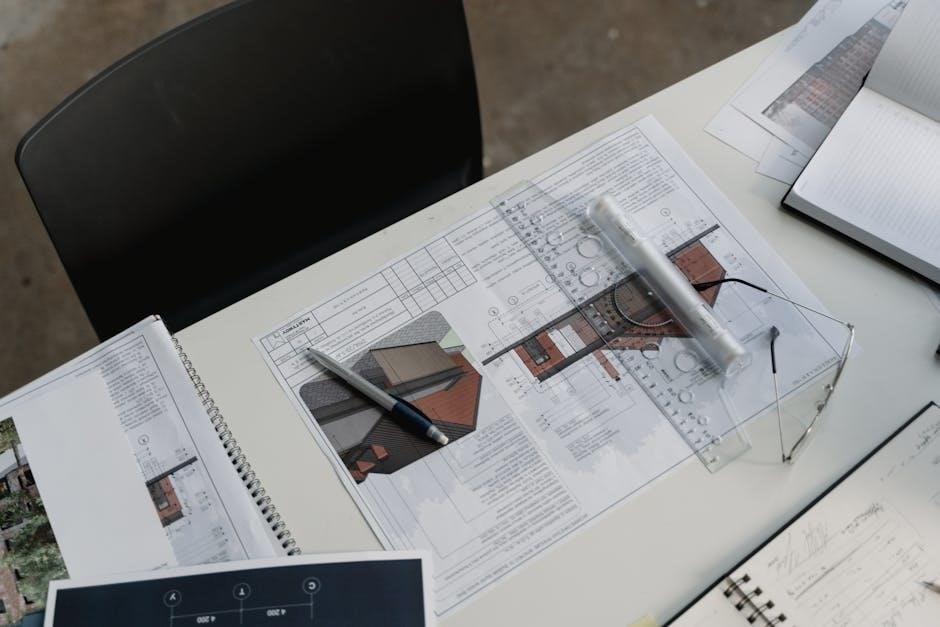The Moxon Vise is a versatile woodworking tool, ideal for precise joinery tasks. Available as detailed PDF plans, it offers step-by-step guides, materials lists, and layout diagrams for easy construction.
What is a Moxon Vise?
A Moxon Vise is a specialized woodworking tool designed to elevate and secure workpieces for precise joinery tasks like dovetailing. It typically features twin screws and two jaws, offering superior control and stability. Unlike traditional vises, it is often placed on top of a workbench, raising the workpiece to a comfortable height for tasks such as routing, carving, or cutting. Its compact design makes it ideal for intricate projects, while its adjustable jaws accommodate various materials. This versatile tool is a favorite among woodworkers for its portability and effectiveness in enhancing workflow efficiency.
Why Use a Moxon Vise?
A Moxon Vise is an essential tool for woodworkers seeking precision and control in joinery tasks. Its elevated design allows for comfortable work on intricate projects, while the twin-screw mechanism ensures even pressure and stability. Ideal for dovetailing, routing, and carving, it enhances workflow efficiency. The vise is portable, fitting seamlessly on any workbench, and its adjustable jaws accommodate various materials. With its compact footprint and versatility, it’s a practical addition to any workshop. Whether for professionals or hobbyists, the Moxon Vise simplifies complex tasks, making it a valuable asset for achieving professional-grade results in woodworking projects.
Importance of PDF Plans for Moxon Vise
Importance of PDF Plans for Moxon Vise
PDF plans for a Moxon Vise are indispensable for a successful build. They provide detailed, step-by-step instructions, ensuring clarity and precision. These plans often include a comprehensive materials list, plywood layout diagrams, and 3D assembly guides, making the construction process straightforward. PDF formats are easily accessible and printable, allowing woodworkers to follow instructions without missing critical details. They also offer a clear visual understanding of the project, reducing errors and saving time. Whether you’re a novice or an experienced woodworker, PDF plans ensure accuracy and confidence in building a functional and durable Moxon Vise for your woodworking needs.

Key Features of Moxon Vise Plans
Moxon Vise PDF plans offer detailed step-by-step instructions, materials lists, plywood layouts, and 3D guides, ensuring precise and efficient construction for woodworkers of all skill levels.
Step-by-Step Directions
The Moxon Vise PDF plans provide clear, detailed step-by-step directions, guiding users through the construction process. From cutting materials to final assembly, each stage is meticulously outlined. The plans include instructions for gluing boards together, trimming them to shape, and edge planing for a smooth finish. Additionally, 3D diagrams and materials lists ensure accuracy and organization. Video tutorials are often included to complement the written instructions, offering visual guidance for complex steps. These comprehensive directions make the building process accessible, even for first-time builders, ensuring a professional-quality Moxon Vise tailored to their workshop needs.
Materials List
Moxon Vise PDF plans typically include a detailed materials list, ensuring builders have everything needed before starting. Common materials include high-quality plywood, lumber for the frame, and hardware like screws, bushings, and guide rods. The plans often specify exact quantities and dimensions, making it easy to prepare. Additional items such as sandpaper, clamps, and wood glue are also listed. Some plans offer flexibility, allowing the use of off-the-shelf hardware or customizable options. This comprehensive list ensures builders can source materials efficiently, avoiding delays and ensuring a smooth construction process tailored to their specific project needs.
Plywood Layout Diagram
The plywood layout diagram in Moxon Vise PDF plans provides a clear visual guide for cutting and arranging wood. It ensures precise alignment and minimal waste by showing exact dimensions and positions for each component. This diagram is essential for understanding how the vise parts fit together, helping builders achieve professional results. It often includes measurements for the main frame, jaws, and support structures, making it easier to follow the assembly process. The diagram is a key component of the plans, offering a visual roadmap to construct the vise accurately and efficiently.
3D Instructions
The 3D instructions in Moxon Vise PDF plans provide a comprehensive visual guide for assembly. These detailed diagrams illustrate how each component fits together, ensuring clarity and precision. Ideal for visual learners, the 3D views simplify complex steps, making it easier to understand the spatial relationships between parts. Available in downloadable PDF format, these instructions enhance the building process by offering a clear, step-by-step visual roadmap. They are particularly useful for first-time builders, helping to minimize errors and ensure a professional finish. The 3D instructions are a valuable resource for anyone constructing a Moxon Vise, offering unparalleled visual guidance.

Types of Moxon Vise Plans
Moxon Vise plans are available in free, paid, and customizable options. Free plans offer basic designs, while paid versions provide detailed instructions and advanced features. Customizable plans allow tailoring to specific needs, ensuring versatility for various woodworking projects and preferences.
Free Moxon Vise Plans
Free Moxon Vise plans are an excellent starting point for DIY woodworking projects. These plans typically include a downloadable PDF with a materials list, plywood layout diagrams, and step-by-step instructions. Many free plans offer basic designs that can be customized to suit individual needs. They are ideal for woodworkers on a budget or those looking to experiment with the Moxon Vise concept before investing in premium versions. Some free plans also provide 3D instructions, making it easier to visualize and assemble the vise. With these plans, you can build a functional Moxon Vise without additional costs, ensuring a rewarding woodworking experience.
Paid Moxon Vise Plans
Paid Moxon Vise plans offer comprehensive, detailed guides for building a high-quality vise. These plans often include enhanced features like customizable jaw sizes, adjustable configurations, and advanced clamping mechanisms. They typically provide a downloadable PDF with precise measurements, step-by-step instructions, and materials lists; Some paid plans also include 3D diagrams for better visualization. While free plans are available, paid versions often deliver superior clarity and professional-grade designs. They are ideal for serious woodworkers seeking precise results and durability. Paid plans may also include expert tips and troubleshooting guides, making them a worthwhile investment for those aiming to create a premium Moxon Vise.
Customizable Moxon Vise Plans
Customizable Moxon Vise plans allow woodworkers to tailor the design to their specific needs. These plans often include adjustable jaw sizes, variable widths, and multiple configuration options. Woodworkers can choose to build single or double vises, depending on their workshop requirements. The plans may also offer flexibility in hardware selection, enabling the use of off-the-shelf components or custom solutions. This customization ensures the vise fits seamlessly into existing workbenches and enhances workflow efficiency. With detailed PDF guides, users can modify dimensions and features to suit their woodworking projects, making these plans ideal for those seeking a personalized setup.

Tools and Materials Required
Building a Moxon Vise requires basic woodworking tools like saws, drills, and clamps. Materials include plywood, screws, bushings, and hardware for the vise mechanism.
Hardware for Moxon Vise
The hardware for a Moxon Vise typically includes screws, bushings, and handwheels, which are essential for smooth operation. Many builders source these components from suppliers like McMaster Carr, ensuring durability and precision. Off-the-shelf hardware can also be used for customization, allowing for unique configurations. Proper installation of these parts is crucial for the vise’s functionality. First-time builders should opt for high-quality materials to ensure long-lasting performance. Detailed PDF plans often include specific hardware recommendations, making it easier to select the right components for your project.
Lumber and Plywood
Choosing the right lumber and plywood is crucial for building a durable Moxon Vise. Domestic hardwoods like maple or cherry are ideal for their strength and stability. Plywood, particularly Baltic birch, is often recommended for its flatness and resistance to warping. Ensure the lumber is properly seasoned to prevent movement after construction. The PDF plans typically include a detailed materials list, specifying the exact thickness and dimensions needed for each component. Cutting the lumber to size accurately is essential for a precise fit. Proper preparation of these materials ensures the vise will function smoothly and withstand the rigors of frequent use in woodworking projects.
Fasteners and Screws
High-quality fasteners and screws are essential for assembling a Moxon Vise. The PDF plans typically specify the exact types and quantities needed, such as machine screws, bolts, and washers. These components ensure proper jaw alignment and smooth operation. It’s important to use durable, corrosion-resistant hardware to withstand heavy use. Many builders opt for hardware from reputable suppliers like McMaster Carr for reliability. The plans often include detailed diagrams for screw placement, ensuring a secure and lasting assembly. Using the right fasteners guarantees the vise will function efficiently and maintain its structural integrity over time.

Step-by-Step Building Process
The Moxon Vise PDF plans outline a clear, structured process, starting with cutting materials to length, followed by gluing boards, trimming, and edge planing for precise assembly.
Cutting Material to Length
Cutting materials to length is the first step in building a Moxon Vise, ensuring all components fit according to the PDF plans. Use a table saw or circular saw for precise cuts, referencing the provided measurements. Double-check each cut against the plan to avoid errors. For accuracy, mark lumber clearly and use clamps to hold pieces steady. Sand cut edges to smooth them before proceeding. This step is foundational for assembling the vise correctly, so attention to detail is crucial. Properly cut materials ensure a solid base for the rest of the project, aligning with the plan’s specifications for a professional finish.
Gluing Boards Together
Gluing boards together is a critical step in constructing the Moxon Vise, requiring precision to ensure proper alignment. Apply wood glue evenly to the surfaces, following the PDF plan’s instructions. Use clamps to secure the boards, applying consistent pressure to prevent warping. Let the glue dry completely, as specified, before proceeding. This step ensures a strong, stable base for the vise. Proper alignment is key to maintaining the vise’s functionality. Once dry, the glued assembly forms the foundation for attaching hardware and completing the build, as detailed in the step-by-step instructions provided in the plan.
Trimming Boards to Shape
After gluing, the boards are trimmed to their final shape using a jigsaw or bandsaw for curved cuts and a router for precise edges. Sanding ensures smooth surfaces. A template can guide accurate cuts, maintaining the vise’s structural integrity. Follow the PDF plan’s dimensions closely for consistent results. Proper trimming ensures the vise functions correctly, making this step crucial for overall performance and usability.
Edge Planing
Edge planing ensures the vise’s surfaces are smooth and even, crucial for proper functionality. Use a hand plane or power tools to remove splinters and imperfections. Sanding follows to achieve a polished finish. Proper edge planing prevents damage to workpieces and enhances the vise’s durability. The PDF plans provide specific instructions for edge preparation, ensuring alignment and accuracy. This step is vital for the vise’s performance, making it safe and effective for woodworking projects. Attention to detail here guarantees a professional-grade finish and optimal usability.

Advanced Features of Moxon Vise
The Moxon Vise offers adjustable jaws, multiple configurations, and robust clamping mechanisms, enhancing precision and versatility for intricate woodworking tasks like dovetailing and joinery.
Adjustable Jaws
The adjustable jaws of a Moxon Vise are a key feature, allowing woodworkers to accommodate varying project sizes and thicknesses. These jaws can be customized to fit specific needs, ensuring precise clamping pressure. The design often incorporates screws and bushings for smooth operation, enabling easy adjustment without compromising stability. This feature is particularly useful for intricate joinery tasks, such as dovetailing, where consistent pressure is crucial. By tweaking the jaw alignment, users can achieve professional-grade results. The PDF plans provide detailed instructions on how to build and fine-tune these adjustable jaws, making the vise adaptable to various woodworking scenarios. This versatility enhances both functionality and efficiency in the workshop.
Multiple Vise Configurations
Moxon Vise plans often include options for multiple configurations to suit different woodworking needs. Users can build two vises with varying capacities, such as one for smaller projects and another for larger tasks. This versatility allows woodworkers to tailor their setup to specific requirements. The plans may also suggest using off-the-shelf hardware, making it easier to replicate or modify configurations. Some configurations involve clamping the vise to the workbench, enhancing stability during use. These adaptable setups ensure that the Moxon Vise remains a flexible and indispensable tool for various joinery and woodworking projects, catering to both amateur and professional craftsmen. This adaptability boosts workshop efficiency and creativity.
Clamping Mechanisms
Moxon Vise plans detail robust clamping mechanisms to ensure secure workpiece hold. Twin-screw designs are common, offering smooth operation and even pressure distribution. The plans often specify hardware like screws and bushings for reliable performance. These mechanisms allow for easy clamping and releasing, making intricate joinery tasks easier. Some configurations include clamping directly to the workbench, enhancing stability. The clamping system is designed to handle various materials and sizes, providing versatility for different projects. Proper installation of these mechanisms is crucial for optimal functionality, ensuring precise control over the workpiece during woodworking operations. This feature makes the Moxon Vise indispensable for accurate and efficient workmanship.

Customization Options
Moxon Vise plans offer customization options, allowing users to build multiple vises, add padded jaws, and utilize off-the-shelf hardware for tailored woodworking solutions.
Building Multiple Moxon Vis
Building multiple Moxon vises allows woodworkers to tailor their setup for specific projects. Many opt to create two vises—one with a smaller capacity (around 16″) and another wider for larger workpieces. This approach enhances versatility, enabling efficient handling of diverse tasks. The PDF plans provide clear instructions, making it easy to adjust the width and customize the design. Additional hardware and materials, such as extra plywood, are required for each vise. This customization option is particularly useful for workshops needing multiple workstations or for tackling complex joinery projects simultaneously, ensuring optimal workflow and precision in woodworking endeavors.
Adding Padded Jaws
Adding padded jaws to your Moxon vise enhances its functionality by protecting delicate workpieces from damage. This feature is particularly useful for handling intricate or finished surfaces. The PDF plans often include instructions for laminating and attaching padded jaws, ensuring a secure and even grip. Woodworkers can use various materials, such as cork or rubber, for the padding. This modification not only prevents marring but also improves control during precise joinery tasks. The step-by-step guides in the plans make it easy to incorporate this upgrade, even for those new to woodworking. Padded jaws are a practical addition for any Moxon vise setup.
Using Off-the-Shelf Hardware
Using off-the-shelf hardware simplifies the Moxon vise building process, making it more accessible for woodworkers. Many PDF plans recommend sourcing screws, bushings, and other components from suppliers like McMaster Carr. This approach ensures compatibility and reduces the need for custom fabrication. The plans often include detailed lists of required hardware, allowing builders to purchase everything efficiently. Off-the-shelf solutions are cost-effective and save time, enabling woodworkers to focus on assembly and customization. This method is particularly beneficial for those new to DIY projects, as it streamlines the process while maintaining the vise’s functionality and durability.

Hardware Setup and Installation
Installing screws and bushings is straightforward with PDF plans. Ensure proper jaw alignment and tighten all components securely for optimal functionality and durability.
Installing Screws and Bushings
Installing screws and bushings is a critical step in building a Moxon Vise. Ensure all hardware is sourced from reputable suppliers like McMaster Carr for durability. Use the PDF plans to locate precise mounting points for screws and bushings, ensuring proper alignment with the vise’s frame.
Drill pilot holes to avoid splitting the wood and securely fasten all components. Tighten screws gradually to maintain even pressure and prevent misalignment. This step ensures smooth operation and longevity of the vise.
Aligning Jaws Properly
Aligning the jaws of your Moxon Vise is crucial for precise operation. Use a combination square to ensure the front and rear jaws are perfectly parallel and flush with each other. Clamp the jaws together temporarily to check alignment before final installation.
Adjust the screws and bushings carefully to achieve even spacing and smooth movement. Refer to the PDF plans for specific measurements and guidelines. Proper alignment ensures the vise will hold workpieces securely and function effortlessly, making it essential for accurate joinery tasks.
Tightening and Adjusting
Tightening and adjusting the Moxon Vise ensures optimal performance. Begin by securing the screws and bushings firmly, using a wrench for precise torque. Check the tightness by gently tugging on the jaws to ensure they hold securely without excessive play.
Adjust the alignment if necessary by loosening the screws slightly and realigning the jaws. Once aligned, tighten the screws in a star pattern to maintain even pressure. Refer to the PDF plans for specific torque recommendations to avoid over-tightening, which could damage the hardware or restrict movement. Proper adjustment ensures smooth operation and reliable clamping power for precise joinery tasks.

Tips for First-Time Builders
Start with detailed PDF plans, ensuring all materials are pre-cut. Follow step-by-step instructions carefully, double-checking measurements. Prioritize proper alignment to avoid costly mistakes and ensure smooth operation.
Choosing the Right Hardware
Selecting the correct hardware is crucial for a functional Moxon Vise. Use high-quality screws and bushings to ensure smooth operation and durability. Consider sourcing hardware from reputable suppliers like McMaster Carr, as they offer durable and precise components. Off-the-shelf options can also work well if chosen carefully. Ensure all parts align properly with the materials specified in your PDF plans. Double-check the compatibility of screws and bushings with your lumber to avoid assembly issues. Proper hardware selection directly impacts the vise’s performance, so take the time to verify each component before purchasing.
Ensuring Proper Alignment
Proper alignment is critical when building a Moxon Vise to ensure smooth operation and even clamping pressure. Follow the PDF plans carefully to align the jaws and screws accurately. Use clamps during assembly to hold components in place while gluing and fastening. Double-check the alignment of the front and rear jaws using a square or straightedge. Ensure the bushings and screws are properly seated and aligned to avoid binding. Once assembled, test the vise by clamping a straightedge to verify even pressure across the jaws. Adjustments may be needed to achieve perfect alignment, ensuring optimal performance for precise joinery tasks.
Avoiding Common Mistakes
Avoiding common mistakes is essential for a functional and durable Moxon Vise. Ensure screws and bushings are properly aligned to prevent binding. Avoid using incorrect hardware, as it may compromise performance. Double-check measurements before cutting materials, as errors can lead to misaligned jaws. Do not skip clamping during glue-up, as this can result in uneven joints. Follow the PDF plans closely, especially for plywood layouts and 3D instructions. Test the vise with scrap wood before final assembly to identify and correct any issues. Proper alignment and precise construction are key to achieving optimal results and ensuring the vise operates smoothly for precise joinery tasks.

Resources and Downloads
Access free and paid Moxon Vise PDF plans, featuring step-by-step guides, materials lists, and plywood layouts. Download SketchUp files and video tutorials for a comprehensive building experience.
Free PDF Plans Availability
Free Moxon Vise PDF plans are widely available online, offering detailed step-by-step guides, materials lists, and plywood layout diagrams. These plans are perfect for DIY enthusiasts and woodworkers of all skill levels. Many websites provide immediate access to downloadable PDFs, eliminating the need for credit card information. Additionally, some plans include SketchUp files and video tutorials for a comprehensive building experience. These resources ensure that you can construct a functional and durable Moxon Vise with ease, even on a budget. The availability of free plans makes this project accessible to everyone, helping you elevate your woodworking projects to the next level.
SketchUp Plans for Moxon Vise
SketchUp plans for the Moxon Vise provide detailed 3D visualizations and precise measurements, making it easier to understand and assemble the vise. These plans complement the PDF guides by offering a comprehensive visual breakdown of the project. They are particularly useful for woodworkers who prefer to see the assembly in three dimensions before starting. Many free and paid plans include SketchUp files, allowing users to explore the design thoroughly. This feature is especially helpful for beginners, as it simplifies the process of interpreting the instructions. With SketchUp plans, you can ensure accuracy and confidence in your Moxon Vise build.
Video Tutorials and Guides
Video tutorials and guides provide an excellent visual aid for building a Moxon Vise, complementing the PDF plans. These resources offer step-by-step demonstrations, making complex assembly steps easier to understand. Many tutorials cover topics like hardware installation, jaw alignment, and troubleshooting common issues. Some platforms offer free video series, while others provide detailed guides for a small fee. These visual instructions are particularly beneficial for beginners, as they break down the process into manageable parts. By combining video guides with PDF plans, woodworkers can ensure a smooth and successful build, even for those new to constructing a Moxon Vise.
Building a Moxon Vise is a rewarding project, made easier with detailed PDF plans. These plans provide clear instructions, ensuring a successful build for woodworkers of all skill levels.
Final Thoughts on Building a Moxon Vise
Building a Moxon Vise is a rewarding project that enhances your woodworking capabilities. With detailed PDF plans, you can easily construct this versatile tool, perfect for precise joinery tasks. The step-by-step guides and materials lists ensure a smooth building process, while the optional SketchUp files and video tutorials provide additional support. Whether you’re a seasoned woodworker or a first-time builder, the Moxon Vise is a valuable addition to your workshop. Its adjustable jaws and sturdy design make it ideal for tasks like dovetailing and routing. By following the plans, you’ll create a tool that will elevate your woodworking projects for years to come.
Encouragement to Start Your Project
Building a Moxon Vise is an exciting and achievable project for woodworkers of all skill levels. With detailed PDF plans and step-by-step instructions, you can confidently bring this versatile tool to life. Whether you’re looking to enhance your joinery skills or simply want to add a practical accessory to your workshop, starting your Moxon Vise project is a great way to refine your craftsmanship. The sense of accomplishment and the utility it provides make it a rewarding endeavor. Gather your materials, follow the guide, and enjoy the process of creating something that will elevate your woodworking experience for years to come.
